Cross Fox
Vulpes vulpes
The cross fox’s tail is bushier than the tail of the average red fox
Advertisement
Cross Fox Scientific Classification
- Kingdom
- Animalia
- Phylum
- Chordata
- Class
- Mammalia
- Order
- Carnivora
- Family
- Canidae
- Genus
- Vulpes
- Scientific Name
- Vulpes vulpes
Read our Complete Guide to Classification of Animals.
Cross Fox Conservation Status
Cross Fox Facts
- Prey
- Birds, small mammals, insects, spiders, worms, reptiles
- Name Of Young
- Cub, pup, kit
- Group Behavior
- Solitary
- Fun Fact
- The cross fox’s tail is bushier than the tail of the average red fox
- Estimated Population Size
- Tens of thousands
- Biggest Threat
- Humans, wolves, coyotes, mountain lions, eagles, bears
- Most Distinctive Feature
- The cross on its back.
- Gestation Period
- 49 to 55 days
- Litter Size
- 5-13 cubs
- Habitat
- Forests, prairies, deserts, mountains, cities, suburbs, tundra, scrub, near rivers, farms
- Predators
- Gray wolves, coyotes, eagles, bears, humans and cougars
- Diet
- Carnivore
- Type
- mammal
- Common Name
- cross fox
- Location
- North America and Canada
Cross Fox Physical Characteristics
- Color
- Red
- Black
- Silver
- Skin Type
- Fur
- Top Speed
- 31 mph
- Lifespan
- 10 to 15 years in captivity, seven years in the wild
- Height
- 14 to 20 inches
- Length
- 18 to 35 inches with 12 to 22 inch long tails, males a bit larger
- Age of Sexual Maturity
- 10 months
- Age of Weaning
- 56 to 70 days
View all of the Cross Fox images!
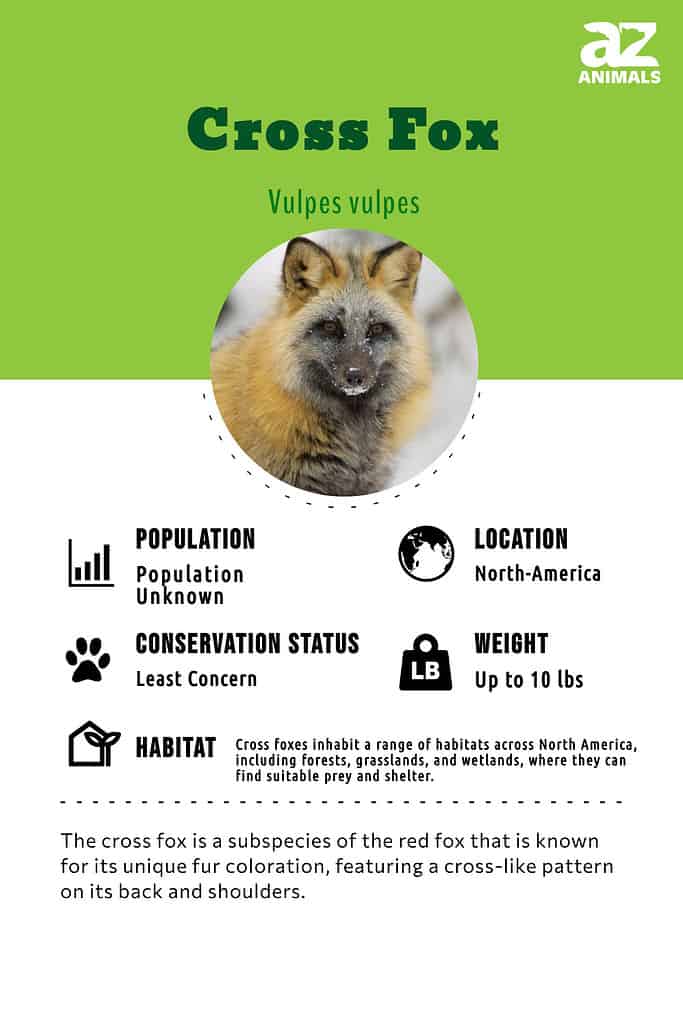
“The partly melanistic version of the red fox.”
A cross fox is a rare animal, but not because its species is endangered. It is a member of Vulpes vulpes whose conservation status is Least Concern. What makes the cross fox rare is its coloration. It is a version of the common red fox that has more melanin than usual and that melanin takes the form of a black cross over the fox’s body. This gives it its name. Other than this, the cross fox is similar to the red fox in nearly every way.
4 Incredible Cross Fox Facts!
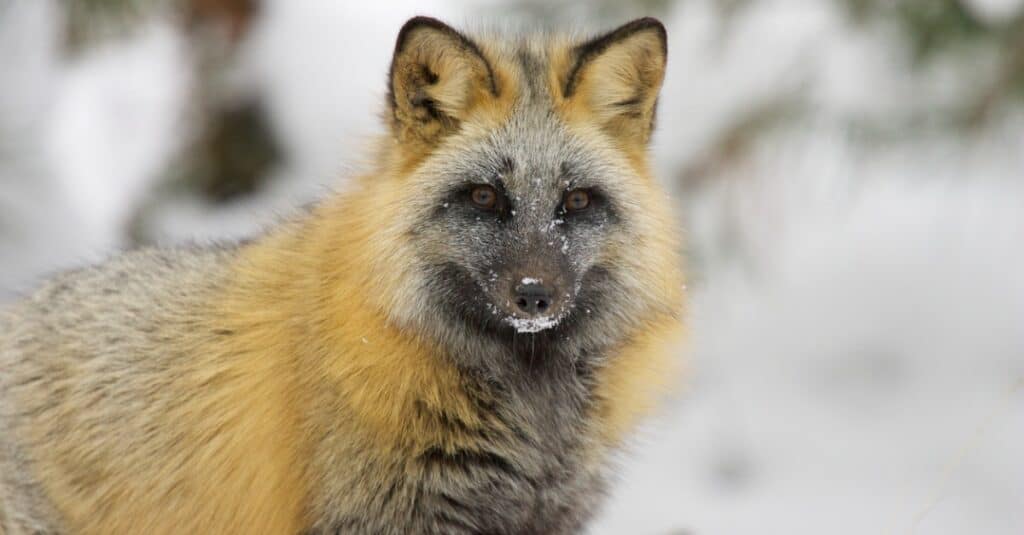
Previously, biologists believed that the cross fox was a distinct species from the red fox, but it has been discovered that they are not, despite being known by the scientific name Canis decassatus.
©iStock.com/moose henderson
Here are four facts about the somewhat rare cross fox:
- Biologists used to think that the cross fox was a separate species from the red fox, but it’s not. Its scientific name was Canis decassatus.
- There are several cross-fox colors, and many have been deliberately created by fur traders. They include the silver cross fox, golden cross fox, cross white mark fox, the pearl cross white mark fox, the pearl cross platinum, and the amber cross fox. The height, length, and weight of some of these designer foxes may differ from the red fox standard.
- Cross foxes come about when a regular red fox mates with a silver fox, which is itself a melanistic type of red fox.
- Biologists believe that as much as 30 percent of Canada’s red foxes are cross foxes.
Scientific Name
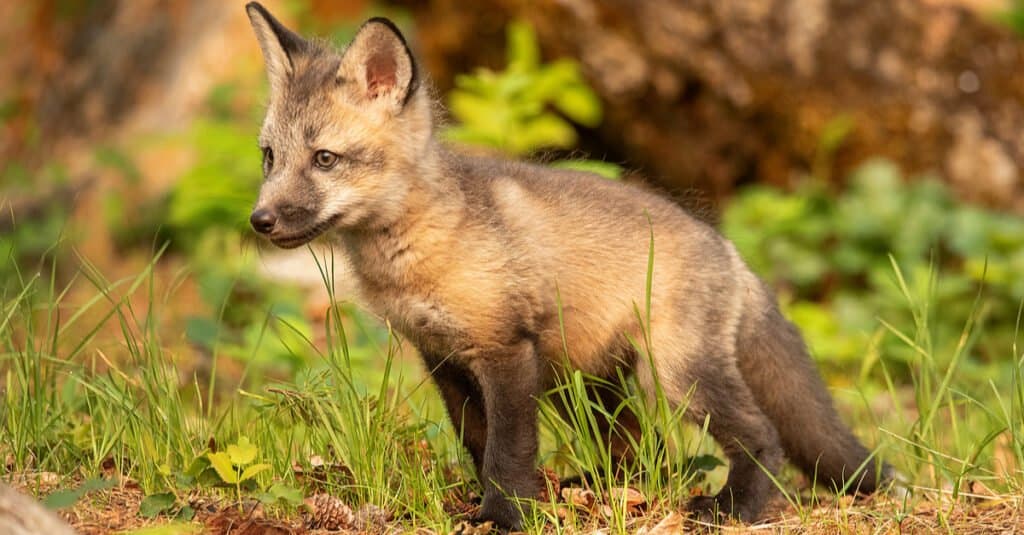
The cross fox is known by its scientific name, Vulpes vulpes, with “Vulpes” being the Latin term for “fox,” suggesting that the name Vulpes vulpes can be interpreted as “the most fox-like fox.”
©Chris Desborough/Shutterstock.com
The scientific name of the cross fox is Vulpes vulpes. Vulpes is the Latin word for “fox,” so Vulpes vulpes may mean something like “the foxiest fox.” There are at least 45 subspecies of the red fox, and at least some of them are subject to the mutation that would lead to the melanism that results in a cross fox.
Additionally, cross foxes can be classified into three distinct color variations which include the Standard, Gold Cross, and Silver Cross.
Some species are:
1. V. v. vulpes
2. V. v. flavescens
3. V. v. harrimani
4. V. v. japonica
5. V. v. hoole
6. V. v. kurdistanica
7. V. v. karagan
8. V. v. necator
9. V. v. montana
10. V. v. silacea
11. V. v. abietorum
12. V. v. tobolica
13. V. v. stepensis
14. V. v. macroura
15. V. v. alascensis
Evolution and Origins
The cross fox is a subspecies of the red fox, which is known for its melanistic color morph, and its name, derived from Latin, roughly translates to “the most fox-like fox.” Among the 45 known subspecies of red fox, the cross fox is one of them.
The cross fox is predominantly found in Canada and other areas of North America, with approximately 30% of red fox populations carrying the mutation that causes them to have cross-like coloring.
Although cross foxes used to reside in parts of the northern United States, like Utah, their populations were eradicated by the fur trade.
Appearance
The cross fox is the size and has the weight and height of a regular red fox, though European foxes and foxes that live in the desert may be a little bigger. The cross fox has a shoulder height of about 14 to 20 inches and weighs from 5 to as much as 31 pounds. It has a pointed muzzle, pointed ears, a lovely, thick pelt, and a bushy tail tipped with white.
This white-tipped tail is how biologists tell red foxes, even melanistic ones, from other species of fox. On top of all this, the cross fox has a band of black fur down its back and a band of black fur across its shoulders, creating the diagnostic cross. There are five claws on each front foot and four claws on each back foot. They also have dewclaws.
As for speed, the cross fox can run as fast as any red fox, which is about 31 miles per hour. It uses that speed to hunt fast-running prey such as mice or rabbits.
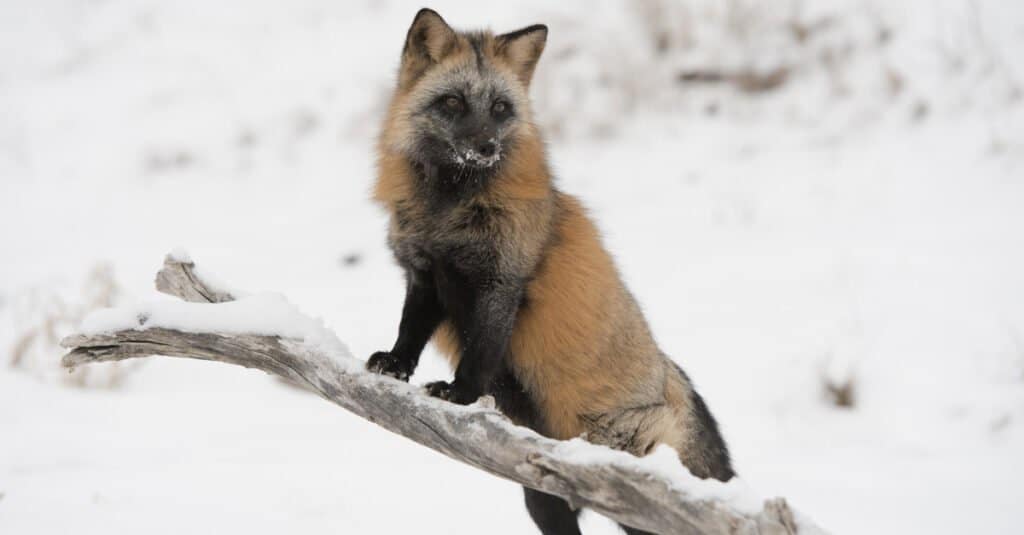
The cross fox has a band of black fur down its back and across its shoulders, creating the diagnostic cross.
©Jeannette Katzir Photog/Shutterstock.com
Cross Fox vs. Red Fox
The difference between a cross fox and a red fox lies mainly in their colors. The cross fox has a black cross on its back that gives it its name. The animal may also have a black or silvery mask, and its tail is a little bushier than that of a regular red fox.
The red fox has mostly red fur on its upper body and white fur on its underside, while the flanks and the sides of the cross fox’s neck are reddish. Both foxes have black fur on their lower legs and the upper side of their ears and golden eyes. The cross fox has been bred and hunted for the fur trade, though its fur wasn’t deemed as valuable as the fur of the silver fox, another melanistic type of the red fox.
Behavior
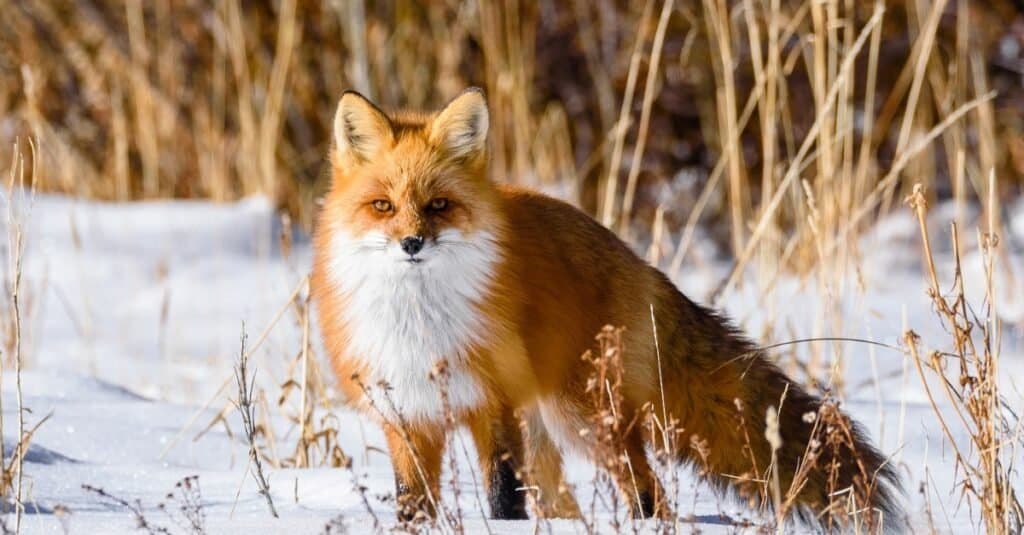
The primary distinction between a cross fox and a red fox can be attributed to their respective colorations.
©iStock.com/Hawk Buckman
Unlike wolves and African wild dogs, foxes are solitary. They don’t form packs and only live with other foxes during the breeding season, and a mother lives with her kits for a few months after their birth. They do have territories that may overlap, and these territories hold the fox’s burrows and dens. Foxes hold on to their territories for life, and some dens are used for generations.
Foxes might raise their kits in larger dens, and these larger dens might have tunnels that lead to dens for caching food or resting. They may dig the burrows themselves or take them over if they belong to weaker animals such as rabbits. Some foxes live in abandoned outbuildings.
These canines have as many as 28 types of vocalizations, and individual foxes can be identified by their voices. They can also communicate through their tails and facial expressions. Like other canines, they have anal sacs and use secretions from these and other glands in the pads of their feet, their lips, jaws, and the upper part of their tail to mark their territory.
They also scent marks through their feces and urine. The fox’s memory and senses are exceptionally keen, especially the senses of smell, vision, and touch.
Habitat
Foxes can hunt day or night, but they mostly start to hunt around twilight or at night. They stalk their prey patiently, then run up and grab it before it can find shelter. Then, the fox carries the prey by the neck to its den to eat it. The fox also has a technique of pinning its prey down if it’s burrowing through thick vegetation. The fox uses its hearing to find the prey’s location then leaps up and pins the prey down with its front feet.
Some people are interested in keeping foxes as pets, but the truth is they are hard to domesticate and don’t make good pets in the end. They need a great deal of space to run around in, they are very hard to train, they have scent marks and they are loud, especially during the breeding season. Indeed, there are some states where having a pet fox is against the law.
The red fox is successful because it can exploit a great variety of habitats. These habitats range from mountains as high as 14,800 feet to forests, deserts, prairies, farms, cities, and suburbs.
Diet

Unlike wolves and African wild dogs, foxes are solitary creatures that only coexist with other foxes during breeding periods and do not form packs.
©iStock.com/moose henderson
Another reason the red fox/cross fox is so successful is that its diet is omnivorous. It readily eats rodents, rabbits, spiders, insects, worms, reptiles such as small snakes and lizards, and birds. It will eat fruit but will also consume carrion and even human garbage. If other food is scarce, it has no problem raiding henhouses.
Predators and Threats
The cross fox’s greatest threat is humans. Humans kill the fox for its lush coat, to control its population, and for no good reason at all during fox hunts. Foxes are wily and though they are smaller than other wild dogs, adult foxes can avoid them. Pups, however, are at risk for predation from coyotes and wolves, bears, mountain lions, and large birds of prey.
Foxes are also susceptible to rabies and can spread this horrifying disease to other mammals, including humans.
Reproduction and Life Cycle
The breeding season for cross foxes depends on where they live. Since many cross foxes live in the north, they most likely breed from February to April. They are at least socially monogamous at this time, for the female, or vixen may mate with several males but will only pair up with one.
During this time the vixen makes a sound that some people describe as the sound of a woman being murdered. This is called the “vixen scream” and is not a cause for alarm. The male may mate with other females, though he’s dedicated to one vixen and her kits, even if not all of them are his.
Just before she gives birth, the female will enter the den and stay there. The male will feed her, but he won’t enter the den. The vixen is pregnant between 51 and 53 days, and she usually gives birth to about five kits, even though she can have as many as 13 at a time.
The baby foxes are helpless and blind but open their eyes about two weeks after their birth. Sometimes older siblings help take care of the new kits, and these siblings and both parents provide the kits with solid food and protect them.
The kits venture out of the den after about a month and are weaned by the time they are two and a half months old. Still, they stay with their mother until fall and are ready to reproduce themselves when they’re about 10 months old.
Population
Scientists believe that the cross fox is as much as 25 percent of the red fox population. The red fox is the most widely distributed canid, indeed, the most widely distributed carnivorous animal on earth, and its conservation status is least concern. The population is stable as of 2021, and the animal is increasing its range.
View all 235 animals that start with CCross Fox FAQs (Frequently Asked Questions)
Are cross foxes carnivores, herbivores, or omnivores?
Cross foxes, like red foxes in general, are omnivores. They eat other animals and fruits and are not above eating carrion and refuse.
What is a cross fox?
The cross fox is one of the red fox’s melanistic morphs. It is not even a subspecies but a fox born with more melanin than other red foxes. In a cross fox, this takes the form of bands of black fur that form a cross on the animal’s body.
How rare is a cross fox?
Cross foxes actually aren’t that rare, but their location is mostly in the northern United States and in Canada.
Is the cross fox still alive?
The cross fox is still very much with us and is in no danger of extinction.
What is a cross fox's diet?
Cross foxes eat rodents such as mice and rats, rabbits, small birds and reptiles, insects, spiders, worms, and other arthropods. They’ll also eat fruit and carrion. A grown cross fox might eat a little over two pounds of food every day.
Thank you for reading! Have some feedback for us? Contact the AZ Animals editorial team.
Sources
- ITIS, Available here: https://www.itis.gov/servlet/SingleRpt/SingleRpt?search_topic=TSN&search_value=180604#null
- Weebly, Available here: https://livingwithfoxes.weebly.com/red-fox-color-mutations.html
- Wikipedia, Available here: https://en.wikipedia.org/wiki/Cross_fox
- FETCH by webMD, Available here: https://pets.webmd.com/can-i-have-a-pet-fox#1
- All Things Foxes, Available here: https://allthingsfoxes.com/what-is-a-cross-fox/
- swnewsmedia, Available here: https://www.swnewsmedia.com/chaska_herald/news/opinion/fascinating-fox-facts/article_77d6936f-2501-527a-9f94-b10202a007f0.html
- CABI, Available here: https://www.swnewsmedia.com/chaska_herald/news/opinion/fascinating-fox-facts/article_77d6936f-2501-527a-9f94-b10202a007f0.html
- the wildlife trusts, Available here: https://www.lancswt.org.uk/blog/charlotte-varela/secret-lives-foxes
- Nature Serve Explorer, Available here: https://explorer.natureserve.org/Taxon/ELEMENT_GLOBAL.2.105935/Vulpes_vulpes

















